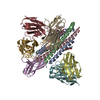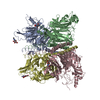[English] 日本語
 Yorodumi
Yorodumi- EMDB-41644: Langya henipavirus postfusion fusion protein in complex with 4G5 ... -
+ Open data
Open data
- Basic information
Basic information
| Entry |  | |||||||||
|---|---|---|---|---|---|---|---|---|---|---|
| Title | Langya henipavirus postfusion fusion protein in complex with 4G5 Fab (global refinement) | |||||||||
 Map data Map data | ||||||||||
 Sample Sample |
| |||||||||
 Keywords Keywords | Langya /  henipavirus / henipavirus /  fusion protein / postfusion / LayVF / SSGCID / fusion protein / postfusion / LayVF / SSGCID /  VIRAL PROTEIN VIRAL PROTEIN | |||||||||
| Biological species |  Langya virus / Langya virus /   Mus sp. (mice) Mus sp. (mice) | |||||||||
| Method |  single particle reconstruction / single particle reconstruction /  cryo EM / Resolution: 3.5 Å cryo EM / Resolution: 3.5 Å | |||||||||
 Authors Authors | Wang Z / Veesler D | |||||||||
| Funding support |  United States, 1 items United States, 1 items
| |||||||||
 Citation Citation |  Journal: Proc Natl Acad Sci U S A / Year: 2024 Journal: Proc Natl Acad Sci U S A / Year: 2024Title: Structure and design of Langya virus glycoprotein antigens. Authors: Zhaoqian Wang / Matthew McCallum / Lianying Yan / Cecily A Gibson / William Sharkey / Young-Jun Park / Ha V Dang / Moushimi Amaya / Ashley Person / Christopher C Broder / David Veesler /  Abstract: Langya virus (LayV) is a recently discovered henipavirus (HNV), isolated from febrile patients in China. HNV entry into host cells is mediated by the attachment (G) and fusion (F) glycoproteins which ...Langya virus (LayV) is a recently discovered henipavirus (HNV), isolated from febrile patients in China. HNV entry into host cells is mediated by the attachment (G) and fusion (F) glycoproteins which are the main targets of neutralizing antibodies. We show here that the LayV F and G glycoproteins promote membrane fusion with human, mouse, and hamster target cells using a different, yet unknown, receptor than Nipah virus (NiV) and Hendra virus (HeV) and that NiV- and HeV-elicited monoclonal and polyclonal antibodies do not cross-react with LayV F and G. We determined cryoelectron microscopy structures of LayV F, in the prefusion and postfusion states, and of LayV G, revealing their conformational landscape and distinct antigenicity relative to NiV and HeV. We computationally designed stabilized LayV G constructs and demonstrate the generalizability of an HNV F prefusion-stabilization strategy. Our data will support the development of vaccines and therapeutics against LayV and closely related HNVs. | |||||||||
| History |
|
- Structure visualization
Structure visualization
| Supplemental images |
|---|
- Downloads & links
Downloads & links
-EMDB archive
| Map data |  emd_41644.map.gz emd_41644.map.gz | 399 MB |  EMDB map data format EMDB map data format | |
|---|---|---|---|---|
| Header (meta data) |  emd-41644-v30.xml emd-41644-v30.xml emd-41644.xml emd-41644.xml | 18.4 KB 18.4 KB | Display Display |  EMDB header EMDB header |
| Images |  emd_41644.png emd_41644.png | 50.7 KB | ||
| Filedesc metadata |  emd-41644.cif.gz emd-41644.cif.gz | 5.4 KB | ||
| Others |  emd_41644_additional_1.map.gz emd_41644_additional_1.map.gz emd_41644_half_map_1.map.gz emd_41644_half_map_1.map.gz emd_41644_half_map_2.map.gz emd_41644_half_map_2.map.gz | 211.3 MB 392.1 MB 392.1 MB | ||
| Archive directory |  http://ftp.pdbj.org/pub/emdb/structures/EMD-41644 http://ftp.pdbj.org/pub/emdb/structures/EMD-41644 ftp://ftp.pdbj.org/pub/emdb/structures/EMD-41644 ftp://ftp.pdbj.org/pub/emdb/structures/EMD-41644 | HTTPS FTP |
-Related structure data
- Links
Links
| EMDB pages |  EMDB (EBI/PDBe) / EMDB (EBI/PDBe) /  EMDataResource EMDataResource |
|---|
- Map
Map
| File |  Download / File: emd_41644.map.gz / Format: CCP4 / Size: 421.9 MB / Type: IMAGE STORED AS FLOATING POINT NUMBER (4 BYTES) Download / File: emd_41644.map.gz / Format: CCP4 / Size: 421.9 MB / Type: IMAGE STORED AS FLOATING POINT NUMBER (4 BYTES) | ||||||||||||||||||||
|---|---|---|---|---|---|---|---|---|---|---|---|---|---|---|---|---|---|---|---|---|---|
| Voxel size | X=Y=Z: 0.9835 Å | ||||||||||||||||||||
| Density |
| ||||||||||||||||||||
| Symmetry | Space group: 1 | ||||||||||||||||||||
| Details | EMDB XML:
|
-Supplemental data
-Additional map: Unsharpened
| File | emd_41644_additional_1.map | ||||||||||||
|---|---|---|---|---|---|---|---|---|---|---|---|---|---|
| Annotation | Unsharpened | ||||||||||||
| Projections & Slices |
| ||||||||||||
| Density Histograms |
-Half map: #1
| File | emd_41644_half_map_1.map | ||||||||||||
|---|---|---|---|---|---|---|---|---|---|---|---|---|---|
| Projections & Slices |
| ||||||||||||
| Density Histograms |
-Half map: #2
| File | emd_41644_half_map_2.map | ||||||||||||
|---|---|---|---|---|---|---|---|---|---|---|---|---|---|
| Projections & Slices |
| ||||||||||||
| Density Histograms |
- Sample components
Sample components
-Entire : Langya henipavirus postfusion fusion protein in complex with 4G5 Fab
| Entire | Name: Langya henipavirus postfusion fusion protein in complex with 4G5 Fab |
|---|---|
| Components |
|
-Supramolecule #1: Langya henipavirus postfusion fusion protein in complex with 4G5 Fab
| Supramolecule | Name: Langya henipavirus postfusion fusion protein in complex with 4G5 Fab type: complex / ID: 1 / Parent: 0 / Macromolecule list: all |
|---|---|
| Source (natural) | Organism:  Langya virus Langya virus |
-Macromolecule #1: Langya henipavirus fusion protein in postfusion state
| Macromolecule | Name: Langya henipavirus fusion protein in postfusion state / type: protein_or_peptide / ID: 1 / Enantiomer: LEVO |
|---|---|
| Source (natural) | Organism:  Langya virus Langya virus |
| Recombinant expression | Organism:   Homo sapiens (human) Homo sapiens (human) |
| Sequence | String: MAFLKSAIIC YLLFYPHIVK SSLHYDSLSK VGIIKGLTYN YKIKGSPSTK LMVVKLIPNI DGVRNCTQKQ FDEYKNLVKN VLEPVKLALN AMLDNVKSGN NKYRFAGAIM AGVALGVATA ATVTAGIALH RSNENAQAIA NMKNAIQNTN EAVKQLQLAN KQTLAVIDTI ...String: MAFLKSAIIC YLLFYPHIVK SSLHYDSLSK VGIIKGLTYN YKIKGSPSTK LMVVKLIPNI DGVRNCTQKQ FDEYKNLVKN VLEPVKLALN AMLDNVKSGN NKYRFAGAIM AGVALGVATA ATVTAGIALH RSNENAQAIA NMKNAIQNTN EAVKQLQLAN KQTLAVIDTI RGEINNNIIP VINQLSCDTI GLSVGIKLTQ YYSEILTAFG PALQNPVNTR ITIQAISSVF NRNFDELLKI MGYTSGDLYE ILHSGLIRGN IIDVDVEAGY IALEIEFPNL TLVPNAVVQE LMPISYNVDG DEWVTLVPRF VLTRTTLLSN IDTSRCTVTE SSVICDNDYA LPMSYELIGC LQGDTSKCAR EKVVSSYVPR FALSDGLVYA NCLNTICRCM DTDTPISQSL GTTVSLLDNK KCLVYQVGDI LISVGSYLGE GEYSADNVEL GPPVVIDKID IGNQLAGINQ TLQNAEDYIE KSEEFLKGIN PSMKQIEDKI EEILSKIYHI ENEIARIKKL IGEAPGGSIE GRGSGGGSHH HHHH |
-Macromolecule #2: 4G5 Fab heavy chain variable domain
| Macromolecule | Name: 4G5 Fab heavy chain variable domain / type: protein_or_peptide / ID: 2 / Enantiomer: LEVO |
|---|---|
| Source (natural) | Organism:   Mus sp. (mice) Mus sp. (mice) |
| Sequence | String: EVQLQQSGAD LVKPGASVKL SCTASGFNIK DTYIHWVKQR PEQGLEWIGR IDPANDNFKY DPKFQGKATI TTDTSSNTAY LQLSSLTSED TAVYYCASVI TTTGYALDYW GQGTSVTVSS |
-Macromolecule #3: 4G5 Fab light chain variable domain
| Macromolecule | Name: 4G5 Fab light chain variable domain / type: protein_or_peptide / ID: 3 / Enantiomer: LEVO |
|---|---|
| Source (natural) | Organism:   Mus sp. (mice) Mus sp. (mice) |
| Sequence | String: DIQMTQSPAS LSASVGETVT ITCRASGNIH NYLAWYQQKQ GKSPQLLVYS AKTLADGVPS RFSGSGSGTQ YSLKINSLQP EDFGSYYCQH FWSSPRTFGG GTKLEIK |
-Experimental details
-Structure determination
| Method |  cryo EM cryo EM |
|---|---|
 Processing Processing |  single particle reconstruction single particle reconstruction |
| Aggregation state | particle |
- Sample preparation
Sample preparation
| Buffer | pH: 8 |
|---|---|
| Vitrification | Cryogen name: ETHANE / Chamber humidity: 100 % / Chamber temperature: 24 K / Instrument: FEI VITROBOT MARK IV |
- Electron microscopy
Electron microscopy
| Microscope | TFS KRIOS |
|---|---|
| Electron beam | Acceleration voltage: 300 kV / Electron source:  FIELD EMISSION GUN FIELD EMISSION GUN |
| Electron optics | Illumination mode: FLOOD BEAM / Imaging mode: BRIGHT FIELD Bright-field microscopy / Cs: 2.7 mm / Nominal defocus max: 1.7 µm / Nominal defocus min: 1.3 µm Bright-field microscopy / Cs: 2.7 mm / Nominal defocus max: 1.7 µm / Nominal defocus min: 1.3 µm |
| Image recording | Film or detector model: GATAN K3 (6k x 4k) / Average electron dose: 63.0 e/Å2 |
| Experimental equipment |  Model: Titan Krios / Image courtesy: FEI Company |
- Image processing
Image processing
| Startup model | Type of model: OTHER |
|---|---|
| Initial angle assignment | Type: MAXIMUM LIKELIHOOD |
| Final angle assignment | Type: MAXIMUM LIKELIHOOD |
| Final reconstruction | Applied symmetry - Point group: C3 (3 fold cyclic ) / Resolution.type: BY AUTHOR / Resolution: 3.5 Å / Resolution method: FSC 0.143 CUT-OFF / Number images used: 60440 ) / Resolution.type: BY AUTHOR / Resolution: 3.5 Å / Resolution method: FSC 0.143 CUT-OFF / Number images used: 60440 |
 Movie
Movie Controller
Controller

















 Z
Z Y
Y X
X

























